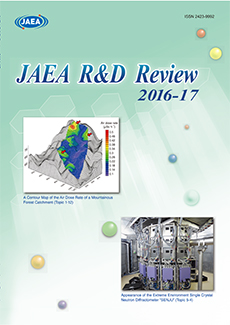The cover is designed with white hexagons similar to the pattern in a tortoise shell, an ancient Japanese symbol of people’s wish for longer lives. Coincidentally, this shape is the same as that of core fuel assemblies for both the prototype fast breeder reactor “MONJU” and the high-temperature engineering test reactor “HTTR”.
The images on the cover show a contour map of the air dose rate of a mountainous forest catchment, which was contaminated by radiocesium released by the accident at the TEPCO’s Fukushima Daiichi NPS (top left) and appearance of the Extreme Environment Single Crystal Neutron Diffractometer “SENJU” (bottom right).
The top left image shows the results of detailed and systematic measurements of the air dose rate in a forest with complex topography. This study showed that the spatial distribution of radiocesium deposition was strongly affected by the topographical features (Chapter 1, Topic 1-12, p.24).
The bottom right image shows the SENJU, one of neutron instruments at J-PARC, which enabled us to observe hydrogens and magnetic spin moments in a crystalline material with a small single crystal under extreme sample environment such as low temperature or magnetic field. This new instrument is a powerful tool for understanding the nature of many functional materials (Chapter 5, Topic 5-4, p.62).

JAEA R&D Review 2016-17
| Published by | |
| Japan Atomic Energy Agency in January 2017 | |
| Editorial Board | |
| Chief editor:Hideaki Mineo | |
| Editors: | Junya Sumita, Tomoaki Suzudo, Ayako Okubo, Hiroyasu Ishikawa, Tadafumi Niizato, |
|
This publication is issued by Japan Atomic Energy Agency (JAEA) on a yearly basis. |
|
|
Address:2-4 Shirakata, Tokai-mura, Naka-gun, Ibaraki-ken 319-1195, Japan Phone:+81-29-282-6387, Facsimile:+81-29-282-5920, |
|
All Rights Reserved by JAEA (c)2017 |
|
<Previous: Promotion of Collaboration